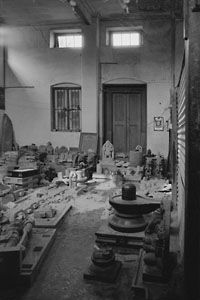alan little’s weblog
indian arts – stonecarving
22nd January 2004 permanent link
I met a stonecarver in a temple in India a couple of years ago, Mr. Nagalingesh. I was impressed by his work, so I asked if he would be willing to do a couple of pieces for me on commission – copies of 12th century temple sculptures I had seen and photographed. He declined, for two reasons. One was that he was already very busy with work for temples both in India and abroad – work that was sacred for him and far more important than mere commercial commissions. The other, he said, was that he wasn’t familiar with the 12th century Hoysala style; what he did was Chalukya style, which dates back to around the 8th century AD.
This was a guy who said his family tradition of stonecarving went back seven hundred years and who worked in a style that was about twice as old as that. Although his main work was for temples he had also done commissions for foreign galleries, and had been invited to spend three years as artist in residence at an art school in Chicago but had declined. He preferred to stay in the combined temple and workshop (seventeenth century) that he shared with his brothers in a quiet street on the outskirts of Mysore. He didn’t appear to mind if he was carving the hundred thousandth Chalyuka style Ganesha that had ever been carved.

Mr Nagalingesh’s workshop
Various thoughts about this: what Mr Nagalingesh does may not be very original, but there’s no question of whether his work is relevant to a modern audience. As long as anybody anywhere in the world is building or renovating Hindu temples, they will need high quality carvings of Hindu gods. And each one has to be individually carved by hand (although I assume poor people building low budget temples can probably get cast concrete versions if they can’t afford people like Mr. Nagalingesh). Compare this to the situation of western classical musicians – there is no great shortage of people who want to listen to Beethoven symphonies either, but you can hear dozens of great recorded versions of those without ever needing to go anywhere near a concert hall. (And the majority of those dozens of great recorded versions will be thirty years old or more).
Is what he does “Art”? I recall reading a comment somewhere – I think it was in The Age of Kali by the excellent William Dalrymple, but I don’t have the book handy to check – by some western sculptor, that Indian traditional stonecarvers are “mere craftsmen” and not “artists”, because what they do doesn’t involve any innovation or personal expression. This begs a whole lot of very big questions – is “craft” different in kind from “art” and if so, is “art” in some sense more important and valuable? Why? Does an “artist” have to be doing, or at least trying to do, something innovative? (*) If carving the hundred thousandth Chalyuka style Ganesha isn’t a creative act, then is taking part in the hundred thousandth performance of a Beethoven symphony? I assume Mr Western Sculptor if he’s trying to be at all consistent would have to say “no” to both – yet both are presumably very important expressions of their soul and spirit for the people doing them.
What Mr. Nagalingesh does is very similar to what the European gothic artisans that Alice talked about did. Not exactly the same: Mediaeval European cathedral builders were extremely technically innovative, always pushing the limits of what they could do with their materials – less stone, more glass – to produce ever greater glories of space and light. Whereas Mediaeval Hindu temples, although they have superlative sculpture, are uninteresting architecturally. It took the muslim conquests and the arrival of the Mughals for anybody to really start doing anything ambitious with buildings in India. (Come to think of it, I don't recall seeing any arches in old Hindu temples. Did Hindus not have the arch? I asume you would be pretty severely limited in terms of what you could do architecturally with stone buildings without arches. Or perhaps they knew about arches but had religious reasons not to use them in temples?)
(*) My personal answer to these questions would be “hmm, well, maybe yes to a degree” but hedged about with lots of qualifications and statements that it is not clear-cut and self evident, and depends a lot on what you think the role of “art” in people’s lives actually is. I certainly don’t kid myself that my photography is in any way treading new ground in visual expression for mankind as a whole; but it is for me personally, and if anybody else happens to like my pictures too (and wants to buy prints of them) well that’s nice, but not as important as me having found a form of creative expression for myself. On the other hand, things that are (or were at the time) genuinely new and different are more interesting than things that aren’t: I’d sooner see a thousand year old chalyuka carving (which I can if I want to) than one made last week by Mr. Nagalingesh; I'd sooner hear Beethoven improvising on piano (which I can’t, unfortunately) than the two hundredth recording of one of his sonatas.
all text and images © 2003–2008